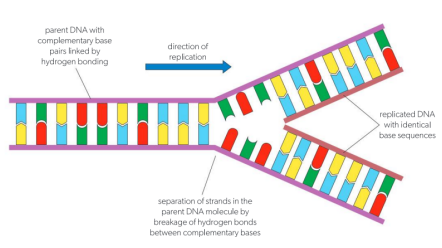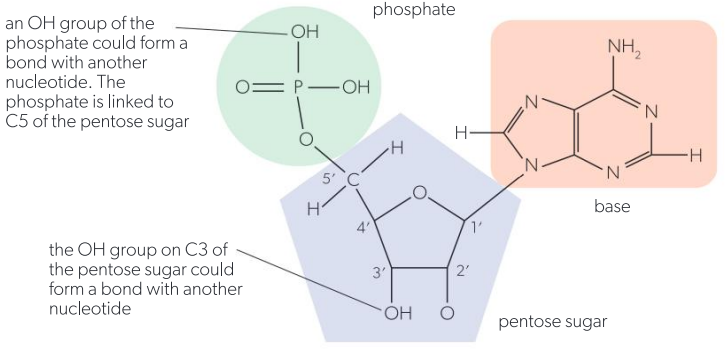D1.1 DNA Replication
1/35
There's no tags or description
Looks like no tags are added yet.
Name | Mastery | Learn | Test | Matching | Spaced |
|---|
No study sessions yet.
36 Terms
Replica
Exact copy of something
DNA replication
Production of new DNA strands with base sequences which are identical to existing strands
Reasons for DNA replication
Reproduction
Growth
Tissue replacement
Replication fork
Site where DNA replication is actively occuring
State how new strands are formed
By adding nucleotides one by one and linking them together
State why DNA replication is referred to as semi-conservative
Presence of two DNA molecules, both consist of
An original strand
A newly synthesised strand

Template strand
Original DNA strand that acts as a “guide” for the replication of new ones
Explain what happens when the wrong base sequence is inserted
No hydrogen bonding between bases
Nucleotide would be rejected
Replisomes
Assemblages of functional subunits
State why DNA strands must be separated prior to replication
So each strand can serve as a template for the new DNA strands
Role of helicase in DNA replication
Unwinding and breaking of hydrogen bonds between DNA strands
Briefly explain how helicase works
One strand is pulled through ring hole
Other is passed to the side of it
DNA is uncoiled
General role of DNA polymerase
Assembles new strands of DNA, using the two original strands as templates
Briefly explain how DNA polymerase works
Adds one nucleotide on strand
PCR
Polymerase chain reaction:
Doubles the quantity of DNA with each cycle
Process of PCR
Denaturing of DNA/RNA
Annealing, temp decreases
Elongating
Amplifying
State why PCR cycle is known as a thermal cycle
Because its steps are triggered by temperature
DNA amplification
Producing more DNA with a specific base sequence
Primer
Short single strand of DNA that binds to the point of DNA where selected base sequence for replication begins
Taq polymerase
Heat-tolerant DNA polymerase- in charge of DNA amplification
Gel electrophoresis
Process by which DNA is separated by length
Process of gel electrophoresis
Put DNA fragments into one end of porous gel
Apply electricity (negative electrode at DNA end)
DNA is also negative, causing repulsion of DNA through the gel
Explain how PCR and gel electrophoresis are used in testing for coronaviruses
Throat/nasal swab is taken
Virus particles and viral RNA are rinsed off in saline solution to produce liquid sample
RNA is converted to DNA using reverse transcription
PCR is used amplify specific viral base sequences (about 35 cycles of PCR are used)
As PCR progresses flourescent markers are attached to any DNA produced, fluorescence leves are monitored, if the go above target, result of test is positive
Explain how PCR and gel electrophoresis are used in testing for paternity tests
DNA sample is obtained
Selected tandem repeats are copied by PCR
DNA produced by PCR is separated according to length of fragment and therefore number of repeats using gel electrophoresis
Pattern of DNA bands is produced on the gel
For paternity testings → DNA profiles of child, mother and father in question are compared
Explain/Describe the structure of a nucleotide
Deoxyribose (DNA) or oxyribose (RNA)
5’ and 3’ ends where nucleotides are received

Outline how DNA polymerase assembles new DNA strands
By linking together a strand of nucleotides with bases complementary to those of the template strand
5’ terminal vs 3’ terminal
5’: site available for linkage is on fifth carbon
3’: site available for linkage is on the third carbon
State the direction in which DNA polymerase always is in
5’ of a DNA nucleotide is added to the 3’ end
Distinguish between replication on the leading and lagging strand
Leading strand | Lagging strand |
|---|---|
DNA polymerase adds nucleotides moving towards replication fork | DNA polymerase adds nucleotides moving away from the replication fork |
Replication is continuous | Replication is restarted/discontinuous |
Replication is completed more quickly | Replication is relatively slow |
RNA primer initiates replication only once | RNA primer initiates replication repeatedly |
Okazaki fragments
Short lengths of new DNA strands
Function of DNA primare
Lays down an RNA primer to provide a binding site for DNA polymerase III
Role of DNA polymerase III
Adds new nucleotides in the 5’ to 3’ direction
Role of DNA polymerase I
Removes all the RNA primers and replaces it with correct DNA nucleotides
Role of DNA ligase
Connects Okazaki fragments and nucleotides laid down by DNA polymerase I and II
DNA proofreading
Done by DNA polymerase II
Removes any nucleotides from 3’ terminal
Replaces mismatches with correctly matched nucleotide
What should be made at the end of DNA replication?
2 identical DNA strands